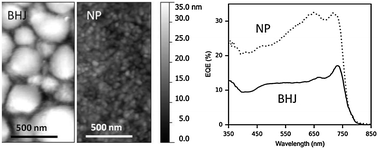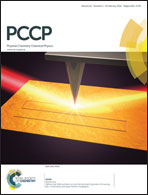Water-based nanoparticulate solar cells using a diketopyrrolopyrrole donor polymer†
Abstract
Organic photovoltaic devices with either bulk heterojunction (BHJ) or nanoparticulate (NP) active layers have been prepared from a 1 : 2 blend of (poly{3,6-dithiophene-2-yl-2,5-di(2-octyldodecyl)-pyrrolo[3,4-c]pyrrole-1,4-dione-alt-naphthalene}) (PDPP-TNT) and the fullerene acceptor, ([6,6]-phenyl C71-butyric acid methyl ester) (PC70BM). Atomic force microscopy (AFM) and scanning electron microscopy (SEM) have been used to investigate the morphology of the active layers of the two approaches. Mild thermal treatment of the NP film is required to promote initial joining of the NPs in order for the devices to function, however the NP structure is retained. Consequently, whereas gross phase segregation of the active layer occurs in the BHJ device spin cast from chloroform, the nanoparticulate approach retains control of the material domain sizes on the length scale of exciton diffusion in the materials. As a result, NP devices are found to generate more than twice the current density of BHJ devices and have a substantially greater overall efficiency. The use of aqueous nanoparticulate dispersions offers a promising approach to control the donor acceptor morphology on the nanoscale with the benefit of environmentally-friendly, solution-based fabrication.


 Please wait while we load your content...
Please wait while we load your content...